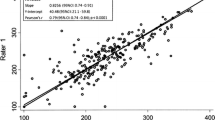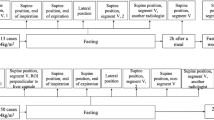Abstract
Purpose
The purpose of the study is to assess the reader agreement and accuracy of eight ultrasound imaging features for classifying hepatic steatosis in adults with known or suspected hepatic steatosis.
Methods
This was an IRB-approved, HIPAA-compliant prospective study of adult patients with known or suspected hepatic steatosis. All patients signed written informed consent. Ultrasound images (Siemens S3000, 6C1HD, and 4C1 transducers) were acquired by experienced sonographers following a standard protocol. Eight readers independently graded eight features and their overall impression of hepatic steatosis on ordinal scales using an electronic case report form. Duplicated images from the 6C1HD transducer were read twice to assess intra-reader agreement. Intra-reader, inter-transducer, and inter-reader agreement were assessed using intraclass correlation coefficients (ICC). Features with the highest intra-reader agreement were selected as predictors for dichotomized histological steatosis using Classification and Regression Tree (CART) analysis, and the accuracy of the decision rule was compared to the accuracy of the radiologists’ overall impression.
Results
45 patients (18 males, 27 females; mean age 56 ± 12 years) scanned from September 2015 to July 2016 were included. Mean intra-reader ICCs ranged from 0.430 to 0.777, inter-transducer ICCs ranged from 0.228 to 0.640, and inter-reader ICCs ranged from 0.014 to 0.561. The CART decision rule selected only large hepatic vein blurring and achieved similar accuracy to the overall impression (74% to 75% and 68% to 72%, respectively).
Conclusions
Large hepatic vein blurring, liver–kidney contrast, and overall impression provided the highest reader agreement. Large hepatic vein blurring may provide the highest classification accuracy for dichotomized grading of hepatic steatosis.





Similar content being viewed by others
Abbreviations
- NAFLD:
-
Nonalcoholic Fatty Liver Disease
- NASH CRN:
-
Nonalcoholic Steatohepatitis Clinical Research Network
- ICC:
-
Intraclass correlation coefficients
- CART:
-
Classification and Regression Tree
- MRI:
-
Magnetic resonance imaging
References
Rinella ME (2015) Nonalcoholic fatty liver disease: a systematic review. JAMA. 313(22):2263–2273
Lazo M, Hernaez R, Eberhardt MS, et al. (2013) Prevalence of nonalcoholic fatty liver disease in the United States: the Third National Health and Nutrition Examination Survey, 1988–1994. Am J Epidemiol 178(1):38–45
Williams CD, Stengel J, Asike MI, et al. (2011) Prevalence of nonalcoholic fatty liver disease and nonalcoholic steatohepatitis among a largely middle-aged population utilizing ultrasound and liver biopsy: a prospective study. Gastroenterology 140(1):124–131
Chalasani N, Younossi Z, Lavine JE, et al. (2012) The diagnosis and management of non-alcoholic fatty liver disease: practice guideline by the American Gastroenterological Association, American Association for the Study of Liver Diseases, and American College of Gastroenterology. Gastroenterology 142(7):1592–1609
Loomba R, Sanyal AJ (2013) The global NAFLD epidemic. Nat Rev Gastroenterol Hepatol 10(11):686–690
Spengler EK, Loomba R (2015) Recommendations for diagnosis, referral for liver biopsy, and treatment of nonalcoholic fatty liver disease and nonalcoholic steatohepatitis. Mayo Clin Proc 90(9):1233–1246
Strauss S, Gavish E, Gottlieb P, Katsnelson L (2007) Interobserver and intraobserver variability in the sonographic assessment of fatty liver. AJR Am J Roentgenol 189(6):W320–W323
Hamaguchi M, Kojima T, Itoh Y, et al. (2007) The severity of ultrasonographic findings in nonalcoholic fatty liver disease reflects the metabolic syndrome and visceral fat accumulation. Am J Gastroenterol 102(12):2708–2715
Fishbein M, Castro F, Cheruku S, et al. (2005) Hepatic MRI for fat quantitation: its relationship to fat morphology, diagnosis, and ultrasound. J Clin Gastroenterol 39(7):619–625
Dasarathy S, Dasarathy J, Khiyami A, et al. (2009) Validity of real time ultrasound in the diagnosis of hepatic steatosis: a prospective study. J Hepatol 51(6):1061–1067
Saadeh S, Younossi ZM, Remer EM, et al. (2002) The utility of radiological imaging in nonalcoholic fatty liver disease. Gastroenterology 123(3):745–750
Yajima Y, Ohta K, Narui T, et al. (1983) Ultrasonographical diagnosis of fatty liver: significance of the liver-kidney contrast. Tohoku J Exp Med 139(1):43–50
Ballestri S, Lonardo A, Romagnoli D, et al. (2012) Ultrasonographic fatty liver indicator, a novel score which rules out NASH and is correlated with metabolic parameters in NAFLD. Liver Int 32(8):1242–1252
Hirche TO, Ignee A, Hirche H, Schneider A, Dietrich CF (2007) Evaluation of hepatic steatosis by ultrasound in patients with chronic hepatitis C virus infection. Liver Int. 27(6):748–757
Caturelli E, Squillante MM, Andriulli A, et al. (1992) Hypoechoic lesions in the “bright liver”: a reliable indicator of fatty change. A prospective study. J Gastroenterol Hepatol 7(5):469–472
Kleiner DE, Brunt EM, Van Natta M, et al. (2005) Design and validation of a histological scoring system for nonalcoholic fatty liver disease. Hepatology 41(6):1313–1321
Noureddin M, Lam J, Peterson MR, et al. (2013) Utility of magnetic resonance imaging versus histology for quantifying changes in liver fat in nonalcoholic fatty liver disease trials. Hepatology 58(6):1930–1940
Landis JR, Koch GG (1977) The measurement of observer agreement for categorical data. Biom Int Biom Soc 33(1):159
Searle SR (1971) A biometrics invited paper. Topics in variance component estimation. Biom Int Biom Soc 27(1):1
Marshall RH, Eissa M, Bluth EI, Gulotta PM, Davis NK (2012) Hepatorenal index as an accurate, simple, and effective tool in screening for steatosis. Am J Roentgenol 199(5):997–1002
Shiralkar K, Johnson S, Bluth EI, et al. (2015) Improved method for calculating hepatic steatosis using the hepatorenal index. J Ultrasound Med 34(6):1051–1059
Lédinghen V, Vergniol J, Foucher J, Merrouche W, Bail B (2012) Non-invasive diagnosis of liver steatosis using controlled attenuation parameter (CAP) and transient elastography. Liver Int 32(6):911–918
Myers RP, Pollett A, Kirsch R, et al. (2012) Controlled attenuation parameter (CAP): a noninvasive method for the detection of hepatic steatosis based on transient elastography. Liver Int 32(6):902–910
Park CC, Nguyen P, Hernandez C, et al. (2016) Magnetic resonance elastography vs transient elastography in detection of fibrosis and noninvasive measurement of steatosis in patients with biopsy-proven nonalcoholic fatty liver disease. Gastroenterology 152:598–607
Berzigotti A, Ferraioli G, Bota S, Gilja OH, Dietrich CF (2018) Novel ultrasound-based methods to assess liver disease: the game has just begun. Dig Liver Dis 50(2):107–112
Lin SC, Heba E, Wolfson T, et al. (2015) Noninvasive diagnosis of nonalcoholic fatty liver disease and quantification of liver fat using a new quantitative ultrasound technique. Clin Gastroenterol Hepatol 13(7):1337–1345.e6
Paige JS, Bernstein GS, Heba E, et al. (2017) A pilot comparative study of quantitative ultrasound, conventional ultrasound, and MRI for predicting histology-determined steatosis grade in adult nonalcoholic fatty liver disease. Am J Roentgenol 208(5):W168–W177
Bohte AE, van Werven JR, Bipat S, Stoker J (2011) The diagnostic accuracy of US, CT, MRI and 1H-MRS for the evaluation of hepatic steatosis compared with liver biopsy: a meta-analysis. Eur Radiol 21(1):87–97
Reeder SB, Hu HH, Sirlin CB (2012) Proton density fat-fraction: a standardized MR-based biomarker of tissue fat concentration. J Magn Reson Imaging 36(5):1011–1014
Yokoo T, Shiehmorteza M, Hamilton G, et al. (2011) Estimation of hepatic proton-density fat fraction by using MR imaging at 3.0 T. Radiology 258(3):749–759
Idilman IS, Aniktar H, Idilman R, et al. (2013) Hepatic steatosis: quantification by proton density fat fraction with MR imaging versus liver biopsy. Radiology 267(3):767–775
Dulai PS, Sirlin CB, Loomba R (2016) MRI and MRE for non-invasive quantitative assessment of hepatic steatosis and fibrosis in NAFLD and NASH: clinical trials to clinical practice. J Hepatol 65(5):1006–1016
Heller MT, Tublin ME (2014) The role of ultrasonography in the evaluation of diffuse liver disease. Radiol Clin North Am 52(6):1163–1175
Bonekamp S, Kamel I, Solga S, Clark J (2009) Can imaging modalities diagnose and stage hepatic fibrosis and cirrhosis accurately? J Hepatol 50(1):17–35
Anvari A, Forsberg F, Samir AE (2015) A primer on the physical principles of tissue harmonic imaging. RadioGraphics 35(7):1955–1964
Whittingham TA (1999) Tissue harmonic imaging. Eur Radiol 9(Suppl 3):S323–S326
Shapiro RS, Wagreich J, Parsons RB, et al. (1998) Tissue harmonic imaging sonography: evaluation of image quality compared with conventional sonography. AJR Am J Roentgenol 171(5):1203–1206
Author information
Authors and Affiliations
Corresponding author
Ethics declarations
Funding
The authors acknowledge Grant support from the National Institutes of Health T32 EB005970-09 and R01 DK106419-03. The study was also supported in part by an investigator-initiated research grant from Siemens to the senior and second senior author. No author of this study is an employee or consultant to Siemens. All data belonged to the authors who had complete control of the manuscript content. The senior author has research grants from Siemens, GE, Philips, and Bayer.
Conflict of interest
C.W.H., A.W., T.W., J.P., S.F.D., A.S.N., E.H., L.D., C.Q.L., A.W, H.J.J., C.F.D., G.C., M.O.B., K.M.R., M.A.V., and M.A. declare that they have no conflicts of interest. F.P. is on the advisory board and speaker bureau of Bayer, on the advisory board of EISAI, on the speaker bureau of Bracco, and has a research contract with ESAOTE. R.L. receives grant funding from Adheron, Arora, BMS, Daiichi-Sankyo Inc., Galectin, Galmed, GE, Genfit, Gilead, Immuron, Intercept, Janssen Inc, KineMed, Madrigal, Merck, NGM, Promedior, Prometheus, Siemens, Sirius, and Tobira and is a consultant or on the advisory committee for Bird Rock Bio, BMS, Boehringer Ingelheim, Celgene, Conatus, Eli Lily, Enanta, Gilead, GRI Bio, Madrigal, Metacrine, NGM, Pfizer, Receptos, Sanofi, Scholar Rock, Zafgen, Arrowhead Research, Conatus, Galmed, Gilead, Intercept, NGM, Nimbus, Octeta, Tobira, GIR, Inc., and Metacrine, Inc. C.S. receives grant funding from Gilead, GE Healthcare, Siemens, GE MRI, Bayer AMRI, GE Digital, GE US, ACR Innovation, performs contracted research for ICON Medical Imaging/Enanta, Philips, Gilead, Shire, VirtualScopics, Intercept, Synageva, is a consultant for Boehringer Ingelheim, is a member of the external advisory board of AMRA Medical and Guerbet (fee paid to the University of California Regents), and a speaker for GE Healthcare and Bayer (fee paid to the University of California Regents).
Ethical approval
All procedures performed in studies involving human participants were in accordance with the ethical standards of the institutional and/or national research committee and with the 1964 Helsinki Declaration and its later amendments or comparable ethical standards.
Informed consent
Informed consent was obtained from all individual participants included in the study.
Rights and permissions
About this article
Cite this article
Hong, C.W., Marsh, A., Wolfson, T. et al. Reader agreement and accuracy of ultrasound features for hepatic steatosis. Abdom Radiol 44, 54–64 (2019). https://doi.org/10.1007/s00261-018-1683-0
Published:
Issue Date:
DOI: https://doi.org/10.1007/s00261-018-1683-0




